
8 minute read
The selection and application of hydraulic vibratory hammers
THE SELECTION AND APPLICATION OF
HYDRAULIC VIBRATORY HAMMERS
by Nick Chua, Country Manager (Philippines), Foundation Associates Engineering Pte Ltd
The different types of equipment available and their merits are presented.
Mr Nick Chua
Introduction
Hydraulic vibratory hammers are used in a wide variety of applications. Apart from their use in driving and extracting elements such as sheet piles and pipes, vibratory hammers are also used for soil densifying or vertical drainage. With currently available technology, it is possible to use vibratory hammers to drive casings for oil & gas pipelines offshore, to a depth of up to 120 m under water.
Principle behind the functioning of a vibratory hammer
A vibratory hammer drives the object into the soil through the centrifugal force generated by its eccentric weights, which, in turn, generates vibrations in the adjacent soil particles, that reduce the soil resistance. The dynamic weight of a hydraulic impact hammer produces a high pulsating load at a low frequency. With a hydraulic vibratory hammer, the opposite will occur. A relatively low steady load is produced at a high frequency. With the low impact of the hydraulic vibratory hammer, the risk of fractures and cracks is eliminated. A vibratory hammer is used to drive sheet piles, pipes or other elements into the soil by vertical vibrations. The adjacent soil particles are initiated into motion and thus the soil is ‘loosened’. The dynamic weight of the hammer will drive the steel casings / sheet piles etc into the soil. Extraction is done using a crane.
Main Components of Vibratory Hammer Suppressor Unit
SUPRESSOR
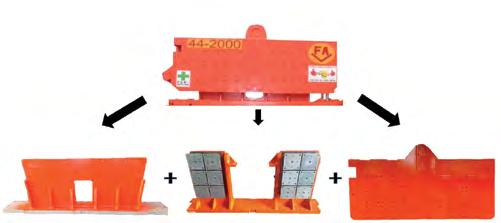
GEAR CASE
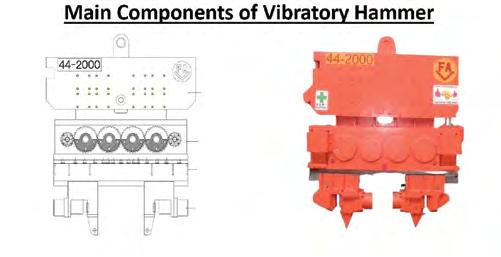
CAISSON BEAM
CLAMP
How does it work?
Vibrator Hammer
Hydraulic Powerpack
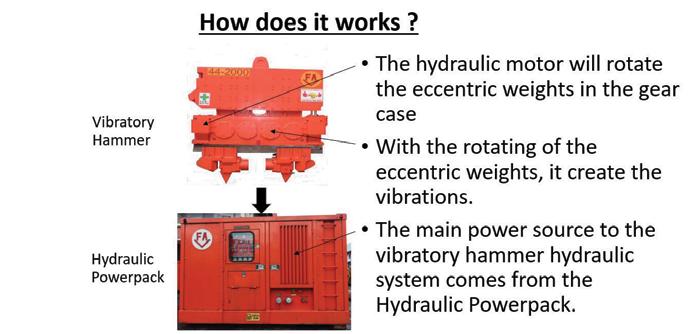
Supressor Structure Elastomers Supressor Housing
The hydraulic motor will rotate the eccentric weights in the gear case.
The rotation of the eccentric weights creates the vibrations
The main power source to the vibratory hammer hydraulic system comes fron the Hydraulic Powerpack.
The selection of a hydraulic vibratory hammer, to use on a particular job site, depends on the following: • Project details: whether the project is a building, refinery, infrastructure, railway or another type of project. • Types of objects to be installed: steel casing, sheet pile, pipe pile etc. • Material of construction of the objects to be installed: steel, concrete, wood etc. • Dimensions and weight of the object to be driven. • Soil condition below ground, with SPT values, preferably, if the soil investigation report is available. • Type and capacity of the lifting equipment available.
Characteristics of the different types of hydraulic vibratory hammers
There are several types of hydraulic vibratory hammers, including the following: • Normal frequency crane suspended hydraulic vibratory hammer. • High frequency crane suspended hydraulic vibratory hammer. • Resonance Free (RF) crane suspended hydraulic vibratory hammer. • Excavator mounted hydraulic vibratory hammer. • Knuckle grip excavator mounted hydraulic vibratory hammer.
Normal frequency vibratory hammers have a constant eccentric moment. When passing the critical frequency area, during start-up and stop, the constant amplitude will cause disturbing negative vibrations in the boom of the crane and in the soil – not just at the spot, but within a considerable perimeter. However, the normal frequency vibratory hammer producing 1600 vibrations per minute (VPM) to 1900 VPM is being used, as the difference in cost between a Resonance Free vibratory hammer and a normal frequency vibratory hammer is quite significant. High frequency hydraulic vibratory hammers have been designed to avoid the resonance which may damage nearby buildings or structures. The pile is driven into the ground under its own pressure or weight from the vibratory hammer. The vibration allows for easy extraction of the pile when the vibratory hammer is pulled. High frequency vibratory hammers generate vibrations from 2000 VPM to 2,300 VPM. Compared to a normal frequency vibratory hammer, a high frequency vibratory hammer produces less vibrations in the surroundings. Tests have demonstrated that the level of vibrations produced by a high frequency vibratory hammer – measured at distance of 2 m from the driving element – equals the level of vibrations produced by a normal frequency hammer at a distance of 16 m. Therefore, when driving in urban areas, it is best to use a high frequency vibratory hammer, to minimise the disturbance to the surrounding area. Resonance Free (RF) hydraulic vibratory hammers eliminate the start-up and shut-down vibrations by utilising a mechanism which enables control over the vibrations. The vibrations of the RF hydraulic vibratory hammers can be switched on and off easily. When the vibrator is starting up, the effect of the eccentric moment is switched off and no vibrations are generated. Once the vibrator has reached its operating frequency, the effect of the eccentric moment is switched on and vibration immediately commences at this frequency. Similarly, during shutdown, the effect of the eccentric moment

A 5-ton series normal frequency crane suspended hydraulic vibratory hammer.
An 8-ton series high frequency crane-suspended hydraulic vibratory hammer at work.
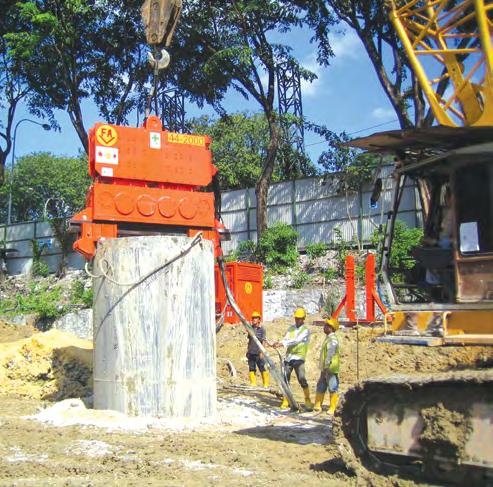
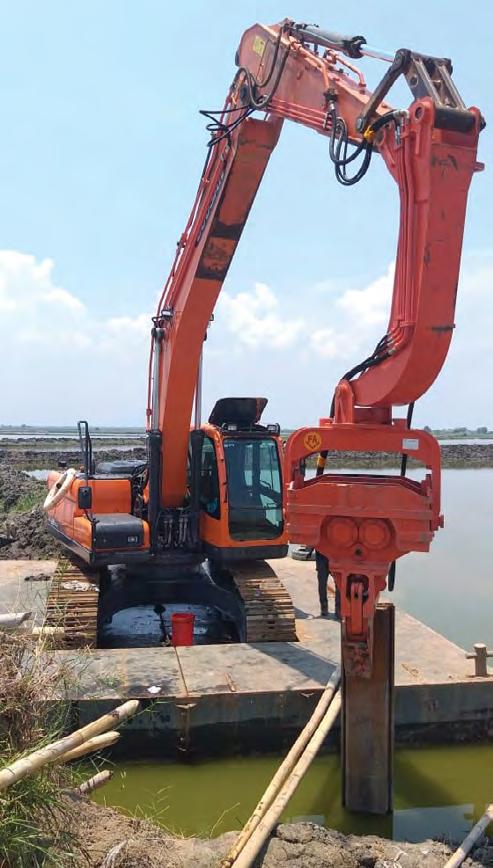
is switched off before the vibrator slows down. This avoids transmitting resonance vibrations to the crane jib and the surrounding environment. In addition, the amplitude can be adjusted to reach the maximum permitted level in sensitive areas. Therefore, RF hydraulic vibratory hammers produce significantly less stress to the carrier’s boom. • The high frequency of the RF hydraulic vibratory hammer produces less ground vibrations. • There are no harmful low frequency vibrations during starting and stopping. • Operators using RF hydraulic vibratory hammers can work much closer to buildings, utility lines and other vulnerable spaces, compared to operators using conventional vibratory hammers. • The driving speed of RF hydraulic vibratory hammers can be adjusted. Hydraulic vibratory hammers installed on excavators are widely used to drive and extract piles. Vibratory hammers are easily attached to excavators by connection brackets. These excavator mounted vibratory hammers draw their hydraulic power from the excavators and are easy to operate. The excavator mounted vibratory hammers do not require any modifications on the excavators themselves. There are several advantages of excavator-mounted vibratory hammers. Their small size contributes to improving workability in confined spaces. Their innovative design and simple operation make their handling easy for the operator. They can be used for different applications such as drainage maintenance and work on marshlands. With user-friendly and mobile functions, excavator mounted hydraulic vibratory hammers can give optimum performance under demanding site conditions. Excavator mounted vibratory hammers can work on construction sites that are in close proximity to residential areas and in confined spaces, with minimum disturbance to the surrounding environment. In addition, the parts are carefully selected to ensure their reliability and optimum performance.

Resonance Free (RF) hydraulic vibratory hammer with hydraulic powerpack. An excavator mounted vibratory hammer driving a sheet pile into a targeted area.

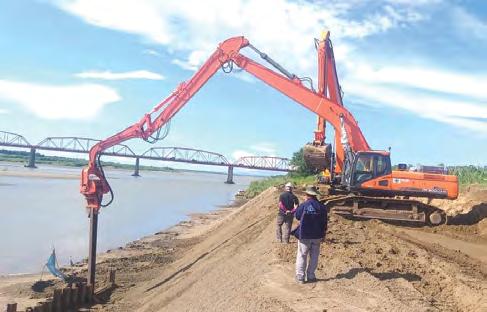
Knuckle grip vibratory hammers can handle, pitch and drive sheet and tube piles. They are capable of accomplishing the whole pile driving process without any need for manual handling of the piles or assisting machinery. Advantages of knuckle grip vibratory hammers include the following: • Fully hydraulic, flexible control. • 360° rotation, +-30° tilt, easy pile pick up. • There is no lifting height limit for the excavator boom and there is no need to extend the boom, to drive long piles. • Core components are reliable brands, ensuring reliable performance • The cooling systems ensure there are no high temperature issues. • The hammers can be used to drive a wide range of piles, including sheet piles, H-piles, tubular steel piles, timber piles etc.
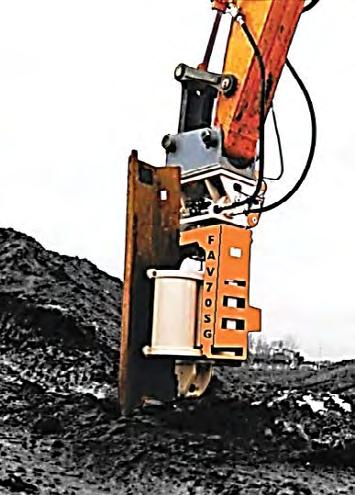
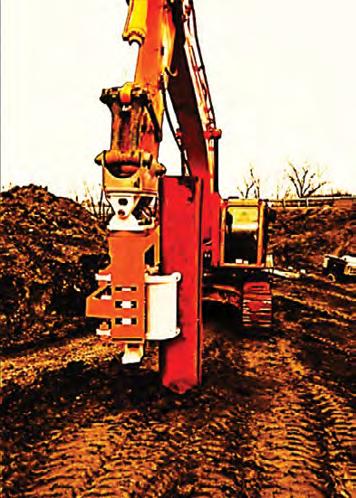
The knuckle grip vibratory hammer.
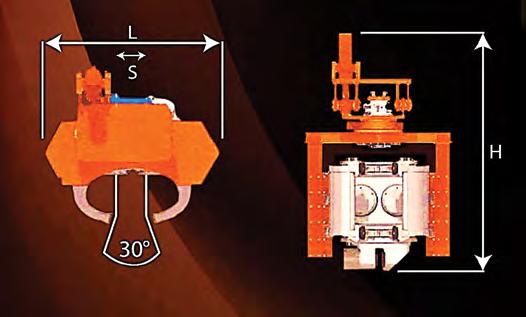
Bentley Systems announces Seequent’s acquisition of Imago
Bentley Systems Incorporated, the infrastructure engineering software company, recently announced that its Seequent business unit has acquired Imago Inc, a developer of cloud-based software for the capture and management of geoscientific imagery. The acquisition will expand Seequent’s technology solutions portfolio while boosting cloud capabilities to help geoscientists and engineers solve earth, environment, and energy challenges. Imago’s cloud-based platform enables the capture, cataloguing, and review of drilling core and chip images from any source, to support every aspect of the geological process from exploration to grade control. Continued development of Imago’s machine learning will lead to a step function in the interpretation of geological data. Mining companies around the world apply Imago’s solution in conjunction with geology data management and modelling tools to enable teams to make more confident, profitable decisions using instantly available, high-quality images. Seequent already integrates its Leapfrog, Oasis montaj, Target, and Minalytix MX Deposit with Imago’s solution, making it easy for geologists, engineers, and other stakeholders to extract knowledge and learn from geoscientific imagery. The goal is to unlock significant potential for mining and other industries, transforming image data into meaningful insights for geological activities. Seequent, founded and headquartered in Christchurch, New Zealand, serves geologists, hydrogeologists, geophysicists, geotechnical engineers, and civil engineers in over 100 countries, and the world’s top mining companies. Its established presence in mineral-intensive geographies such as South America and southern Africa is expected to accelerate Bentley’s overall opportunities in these regions with significant infrastructure requirements. In turn, Bentley’s established presence in China, and its mainstay reach across civil engineering sectors, is expected to accelerate Seequent’s expansion in new markets. Seequent’s products include Leapfrog, its leading product for 3D geological modelling and visualisation, Geosoft for 3D earth modelling and geoscience data management, and GeoStudio for geotechnical slope stability and deformation modelling. Bentley’s complementary geotechnical engineering software portfolio, including PLAXIS, gINT, and OpenGround, will be integrated in due course to support open digital workflows from borehole and drillhole data to geological models and geotechnical analysis applications.






